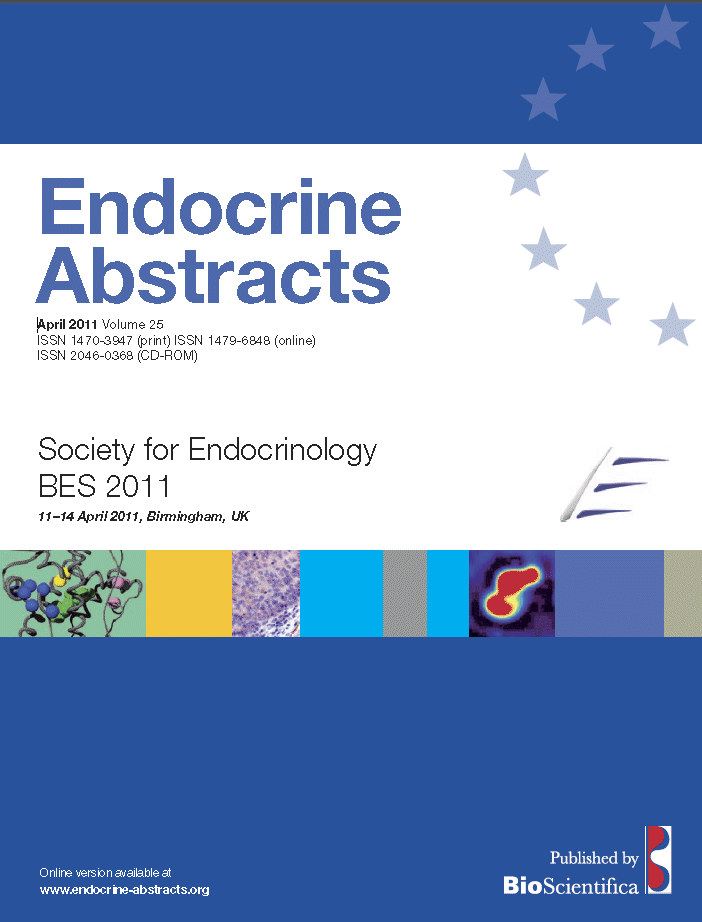Oral Communications
Pituitary and thyroid
ea0025oc3.1 | Pituitary and thyroid | SFEBES2011
Development of a novel mass spectroscopy-based method for determining serum IGF1: assessment in a cohort of newly diagnosed subjects with acromegaly
Halsall David , Kay Richard , Taylor Kevin , Annamalai Anand , Kandasamy Narayanan , Wark Gwen , Pleasance Steve , Gurnell Mark
ea0025oc3.2 | Pituitary and thyroid | SFEBES2011
Determination of method-specific normal cortisol responses to the short Synacthen test
El-Farhan Nadia , Pickett Alan , Ducroq David , Bailey Catherine , Parham Kelly , Morgan Nicola , Armston Anne , Evans Carol , Rees Dafydd Aled
ea0025oc3.3 | Pituitary and thyroid | SFEBES2011
miR-107 inhibits the expression of aryl hydrocarbon receptor interacting protein (AIP) and is potentially involved in pituitary tumorigenesis
Trivellin Giampaolo , Igreja Susana , Garcia Edwin , Chahal Harvinder , Butz Henriett , Patocs Attila , Grossman Ashley , Korbonits Marta
ea0025oc3.4 | Pituitary and thyroid | SFEBES2011
PTTG promotes mitogenic mechanisms in thyroid cells through autocrine pathways of interaction with growth factors
Lewy Gregory , Ryan Gavin , Stewart Sarah , Read Martin , Smith Vicki , Fong Jim , Warfield Adrian , Eggo Margaret , Seed Robert , Sharma Neil , Kwan Perkin , Franklyn Jayne , McCabe Christopher , Boelaert Kristien
ea0025oc3.5 | Pituitary and thyroid | SFEBES2011
Metastatic characteristics and radiosensitivity of thyroid carcinoma cells depends on HIF-1 and PI3K signalling in vitro and in vivo
Burrows Natalie , Babur Muhammad , Resch Julia , Ridsdale Sophie , Williams Joseph , Brabant Georg , Williams Kaye
ea0025oc3.6 | Pituitary and thyroid | SFEBES2011
Morbidity in patients with endogenous subclinical hyperthyroidism
Vadiveloo Thenmalar , Donnan Peter , Cochrane Lynda , Leese Graham
ea0025oc3.7 | Pituitary and thyroid | SFEBES2011
Thyroid dysfunction and clot structure: a mechanism for increased thrombotic risk in hyperthyroid individuals?
Hooper Jonathan , Orme Steve , van Zaane Bregje , Hess Katharina , Alzahrani Saad , Standeven Kristina , Pearce Simon , Grant Peter , Ajjan Ramzi
ea0025oc3.8 | Pituitary and thyroid | SFEBES2011
Assessment of the UK iodine status: a National Survey
Vanderpump Mark , Lazarus John , Smyth Peter , Burns Robert , Eggo Margaret , Han Thang , Williams Graham , Torlinska Barbara , Mullan Karen , Pearce Simon , Razvi Salman , Lean Mike , Aspray Emile Combet , Bannon Denise , Abraham Prakash , Vadia Bijay , Leese Graham , Laurberg Peter , Boelaert Kristien , Franklyn Jayne




